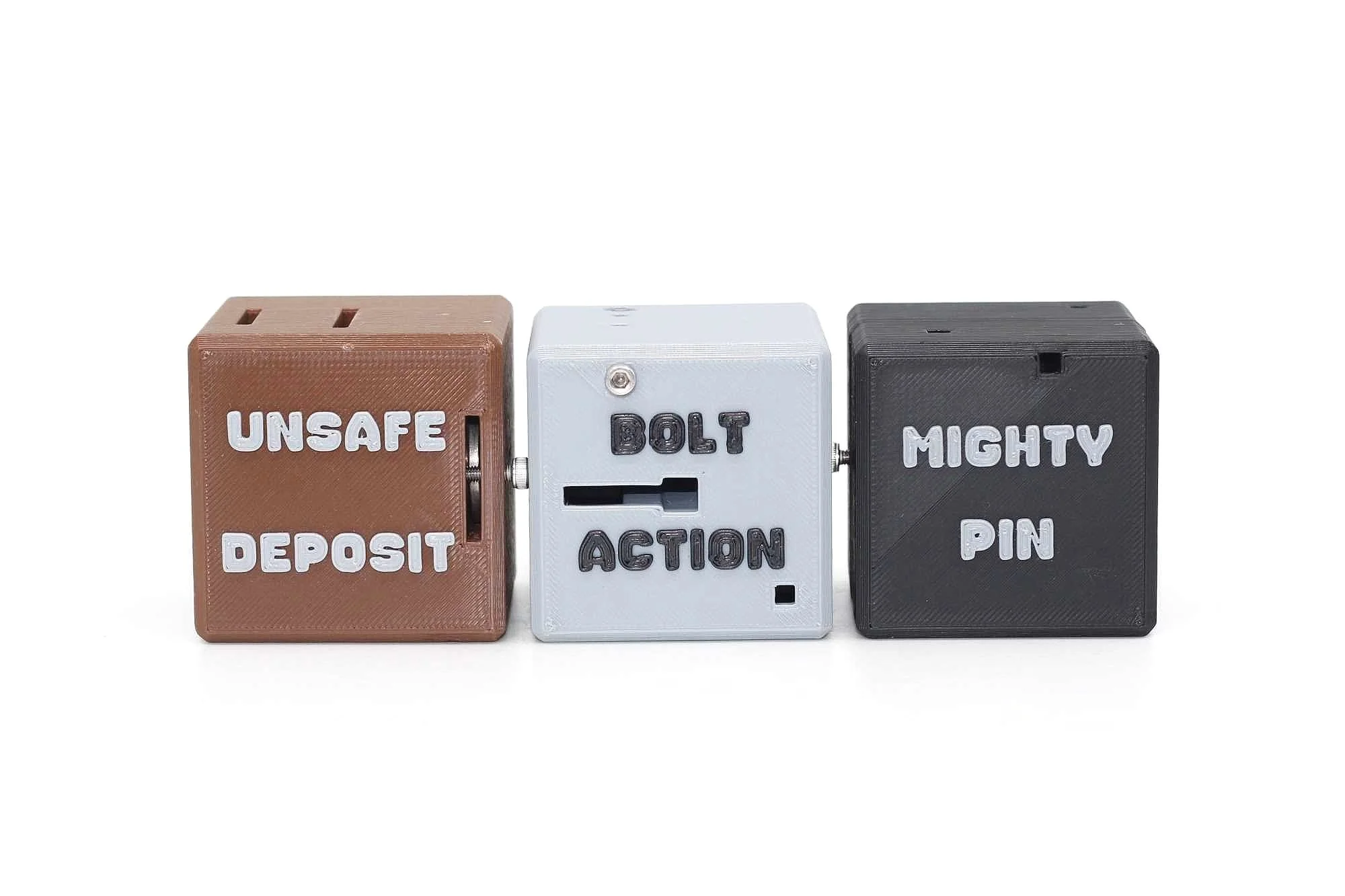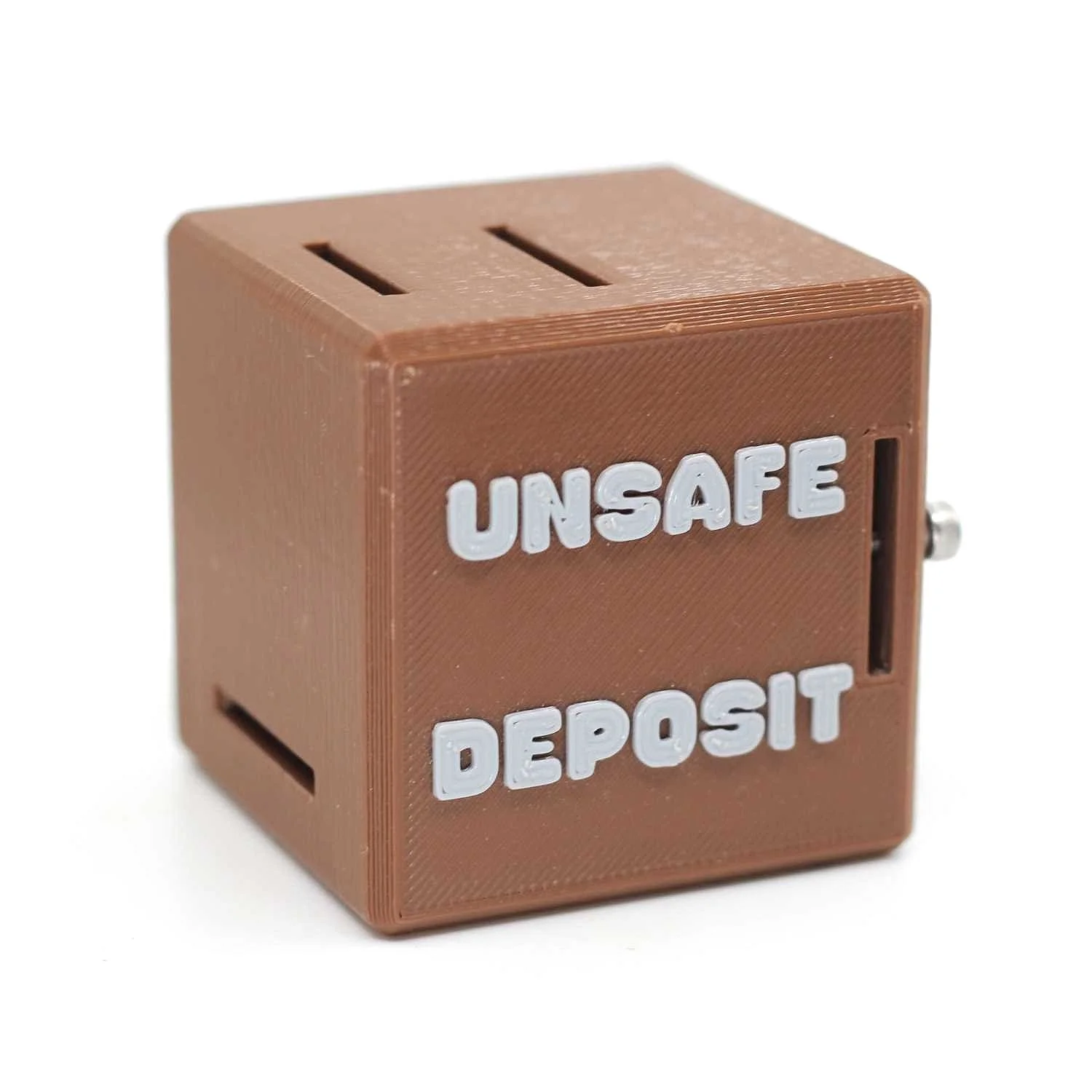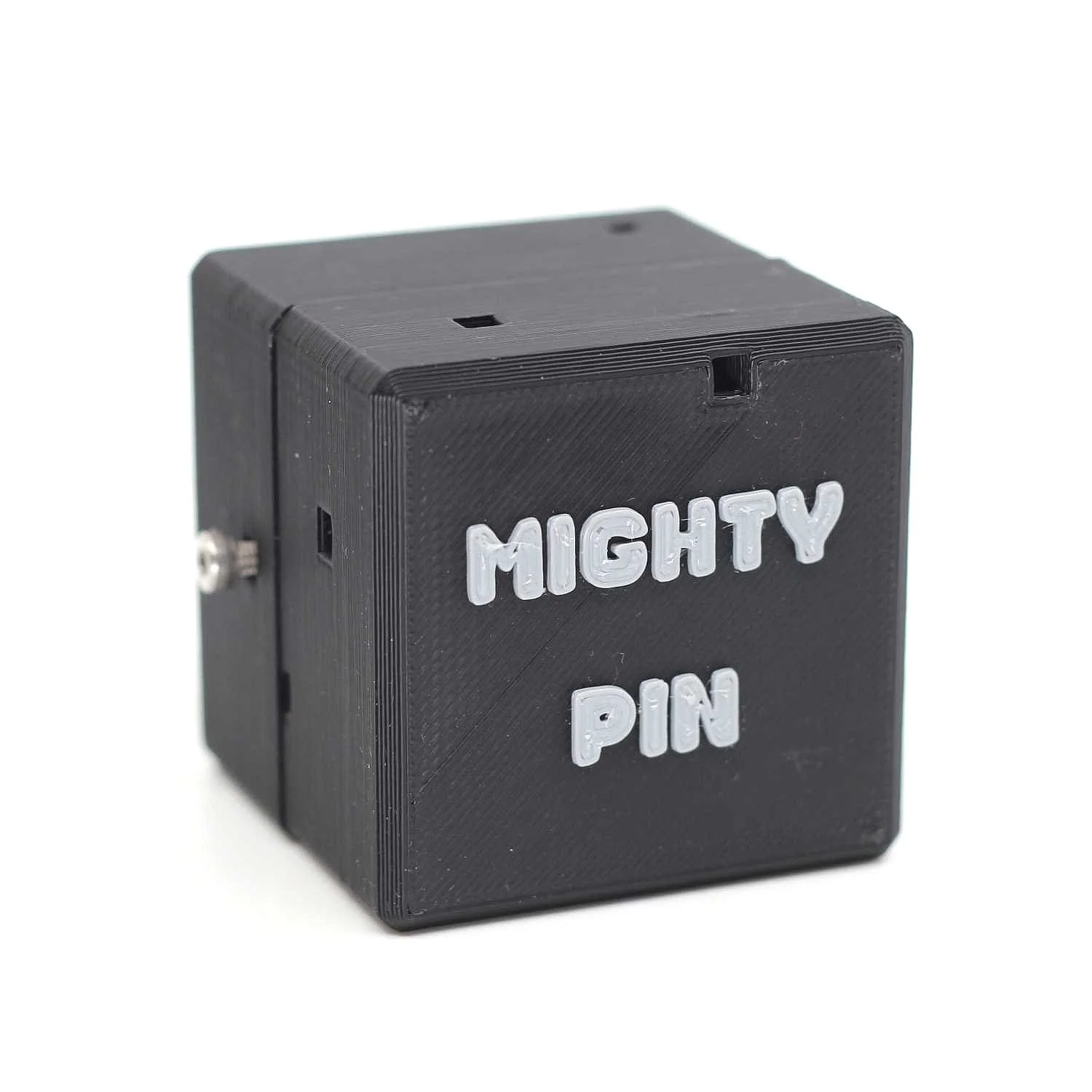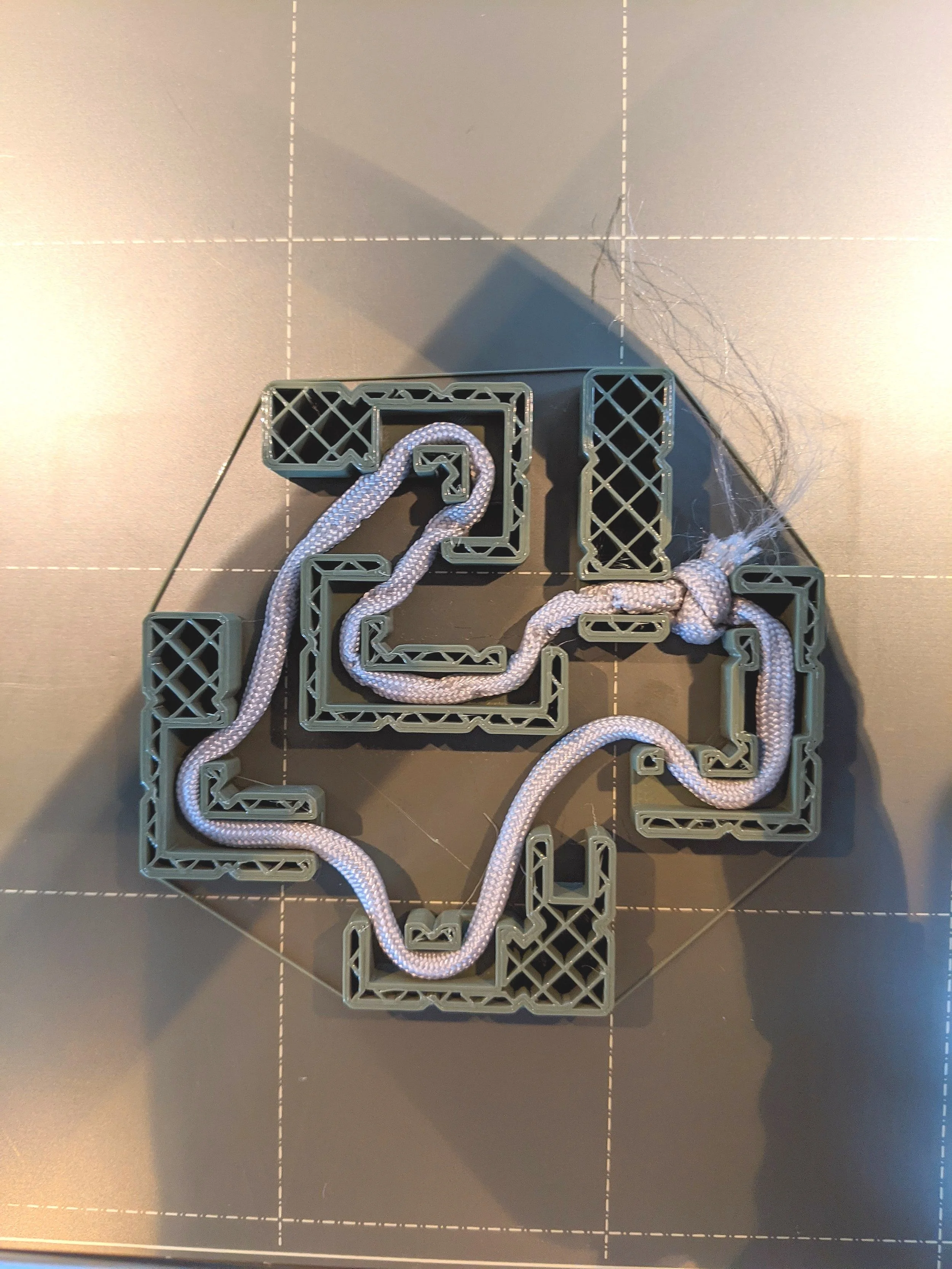Big Things
Unsafe Deposit SD Cube Series
They say big things come in small packages. I’m sure that was just some clever PR job from long ago, to make what seemed to be comparatively little sound like a lot more. Because, after all, big things come in BIG packages, too!
The Unsafe Deposit SD Cube Series by Alan Lunsford
But in this particular case, the saying and sentiment are most certainly true. A little over three years ago now, Alan Lunsford began introducing the world to these marvelously compact little puzzle cubes that pack a punch. Just two-inches cubed each, they appear fairly innocuous as 3D printed objects, with coins or screws protruding, holes or slots here and there, and clever names adorning one side. The goal with each is to work through the many tricky steps to free a final coin or prize. What began with Unsafe Deposit, a very clever multi-coin discovery puzzle, ultimately became a three cube set, which sold out over and over very quickly, once word got out that these little puzzles were an incredible bang for the buck. Alan, who is a civil engineer, has now reorganized his printing capabilities and is back in production. Like many new designers, he had always liked puzzles and games, but he stumbled on the world of mechanical puzzle enthusiasts during the pandemic, when we all had some unexpected extra time. He shared the story of his SD Cube series with me recently.
it’s safe to say
“Starting to make puzzles was a coincidence, as far as I am concerned. Late 2019, I bought my first 3d printer. I had played with one in college years before. But they were garbage and somehow also the price of a new car. I had written them off for a long time, but they came back on my radar when printers became cheap and good. When Covid hit, I found myself with a lot of free time. I designed a good bit of stuff during that time. Games, marble drop courses and puzzles. It was during a search of other puzzles out there that I landed in the discord. Finding other folks interested in this stuff, while having a lot of newfound free time and also getting into 3d printing (which allowed me to manufacture things in my 1 bedroom apartment) was just a perfect storm.”
The mechanical puzzle discord has been a fertile playground for new designers to meet and encourage one another. Alan was inspired there by Jared Peterson, creator of the clever Ice Box puzzle, which can be found along with dozens of other great designs on his Etsy shop at CoreMods. “When I joined the discord, [Jared] was the one really pushing 3d printing into the forefront. He had been successful with his egg series, showing that there was a desire for 3d printed puzzles. He also showed with that same series that 3d printers could do some things that other manufacturing methods couldn't (at least as easily). The idea of having puzzles that have all their mechanisms formed during the printing process was wild.”
will give you a jolt
Creating a printed object that has internal components and moving parts yet is fully formed and fused as a single unopenable piece when complete requires a ton of planning and a labor intensive print process. “All of the printed mechanisms inside the puzzles are printed first, typically in larger batches. Any hardware that needs to be added to the individual components are added either mid print or after they are made, on an as-needed basis. Once all of the components are made the really tricky part of the build comes. Each main body of the puzzles are setup to print in such a way that the printer pauses when it reaches a certain Z-height. At this time, I insert the components that are needed. For each puzzle this is about a 4 hour process. At the end of printing the puzzle comes off of the printer fully formed, no post processing needed. However, the big risk you have using this method is that if at any of the pauses you forget to put a component in, or the component you put in doesn't work properly for some reason, the puzzle is useless and must be scrapped. I have lost many puzzles this way and it can be very frustrating after tending a printer for 4 hours.”
Alan had created a different set of penny release puzzles he calls “Cop Out”. “The SD cubes are an evolution of the Cop Out series in a lot of ways. Cop Out had been an initial exploration of the idea of putting things like hardware and even other 3d printed parts inside a main 3d printed body. UD [Unsafe Deposit] was the first SD box to come out of this same design goal.
small but mighty
I actually think on a couple different levels, my puzzles are a story of increment. The idea of nesting mechanisms inside 3d printed frames grew from pre-Cop Out designs all the way through all three of the currently released SD puzzles. Complexity grew from each design as I wanted to achieve new stuff. I also think on an individual puzzle basis, the puzzler can probably sense this idea of increment. In each of the puzzles the goal is for there to be some sort of mechanical "theme". Each step as you progress through that theme is me trying to figure out more and more clever ways to use the few tools you have to do something new. Hopefully, that mirror's the puzzlers experience as they have to get more creative on each step.”
early concepts (courtesy of Alan Lunsford)
Alan starts the design process with a few general ideas, but the whole experience is an evolution. “Typically before I get into CAD, I have two things figured out in my head. The first step and the last. These are critical because the first step needs to be something that requires no tools, but won’t come apart during shipping. And the last step is what gets the coin into the puzzler's hands. Everything in between gets figured out along the way, and there are a lot of changes. Mechanisms get scrapped for a number of reasons. Not interesting enough, too big, too finnicky. All good reasons for a step to be eliminated. Most of the scrapped ideas can find life in one way or another in a future puzzle and can offer a good starting point for where I want to go next.”
tester copies of Cop Out (courtesy of Alan Lunsford)
Alan faced all the usual obstacles and challenges of design and production imaginable. He outlines his typical comically ironic workflow now:
1. Have an initial idea
2. Realize that it isn't going to work at all during the CAD process. Abandon idea in frustration
3. Be doing something else entirely, and figure out a way to fix my issue in design. Redesign via CAD.
4. Print my first iteration of my puzzle. It is a brick. Abandon idea in frustration.
5. Be doing something else entirely, and figure out a way to fix my issue in production. Redesign.
6. Be happy with the result, send to playtesters, they break it in ways I never imagined. Redesign.
7. Make a handful of production copies, discover some dumb way to shortcut the puzzle that no one found before. Throw them away and redesign.
8. Send out to the world and nervously watch my inbox in case people find some way to break the solve.
Mighty Pin might (courtesy of Alan Lunsford)
“I have gotten much better at designing things for larger scale production. I did not have the mindset that I am going to have to make hundreds of these when I started and it shows. A good example of this is Bolt Action. That puzzle requires 27 individual components and 7 pauses in order to construct a single puzzle. It's a production nightmare. I have gotten better at minimizing the number of pauses and extra components required per puzzle.” The world of 3D printing requires a whole new skill set from designers, compared to more traditional production in wood or metal. But it also allows new possibilities, where complex prototypes can be made and tested prior to finalizing a design.
Cop Out 3 early prototype
“Iteration and playtesting are the name of the game. So far, I have been pretty successful in catching major flaws before production. Big thanks to my many playtesters (10+) for that. One very notable situation was I had to throw out somewhere around 20 Mighty Pins after I discovered you could brick the puzzle with a very specific sequence of moves. I had to walk away for a bit after that one.” There’s a lot to appreciate in both the many testers willing to experience and critique an early prototype that may not work well, and a designer’s willingness to revisit an idea over and over until it is great.
Stringy Block Disassembled (courtesy of Alan Lunsford)
Alan also shared a few interesting anecdotes about his designs. “There is another puzzle designer that is one of my playtesters. And I help playtest some of his designs as well. We have, in multiple instances, been working on the same idea at the same time with no knowledge of the other's work. We aren't quite sure why, but it's actually interesting to see how two people solve the same problems. The end results have always been very different even if the starting inspiration was the same.
Stringy L Block mid-print (courtesy of Alan Lunsford)
I often think about and get a kick out of the fact that I decided to start making coin release puzzles during the pandemic when coin shortages were a thing. Banks would not give you rolls of coins. At one point I got so desperate I was buying small things as close to $1.01 in cash as possible to get change back, and buying coworker's change jars. The latter was much more successful and was how I continued to ship puzzles.
Tri-nary test, disassembled (courtesy of Alan Lunsford)
I have had a number of people reach out to me and express their enjoyment of my puzzles. I am always very thankful for that. On a few occasions in the past few years I have had designers tell me that they have been inspired to make something after playing with one of my puzzles and that is an absolute joy.”
27?
With the success of his initial SD Cube puzzles, people are naturally hungry for more from this designer. “I am working on a couple of new puzzles that utilize the same form factor/price point as UD, BA and MP. One which has made it through playtesting and another that is in the initial prototyping stages. My dream would be to get both of those produced this year. We shall see. I also have a good concept of something larger that I have wanted to do for a while, but has been prohibited in a lot of ways by the speed of 3d printing. Printers are quite a bit faster now, so there may be an opportunity to make it happen.
It's been a pleasure to be able to make these puzzles and see folks share in the experience of solving them on the discord. I am very thankful to those who supported me very early on and would encourage anyone that has the means to do so to support designers' first puzzles, as it makes a huge difference when you can. Thank you very much!”
Little Wonder
Here's a toast to these little wonders, palm sized pocket puzzles that are full of surprises. The cocktail was created by Fransos, a camera operator from Oslo, Norway. He posted it in 2016 on the Kindred Cocktails site, and there is little more to be found about it. It is notable for using a full two ounces of Cynar as the base spirit, and has a little bit of gin in a supporting role. Cynar is a dark and deliciously herbal Italian amaro distinguished by the prominent use of artichoke, which is featured on the bottle label. The amaro does not actually taste like artichokes however, and can be a surprise hit in a cocktail. It’s slightly sweet like many amari, slightly bitter, and very tasty.
it’s a little wonder full
It also turns out to pair extremely well with pineapple. The gin gives the drink more body and helps it hold up to the sweeteners, which are balanced very well. Overall the drink was really surprising and delicious. Just like these wonderful little puzzle cubes. Cheers!
modern wonders
Little Wonder by Fransos
2 oz Cynar
½ oz gin
¾ oz lime
¾ oz pineapple
½ oz simple syrup
1 dash Angostura bitters
Shake with ice and strain into a favorite glass up, no garnish.
explore more:
Find Alan Lunsford puzzles at Kinetic Crafts















